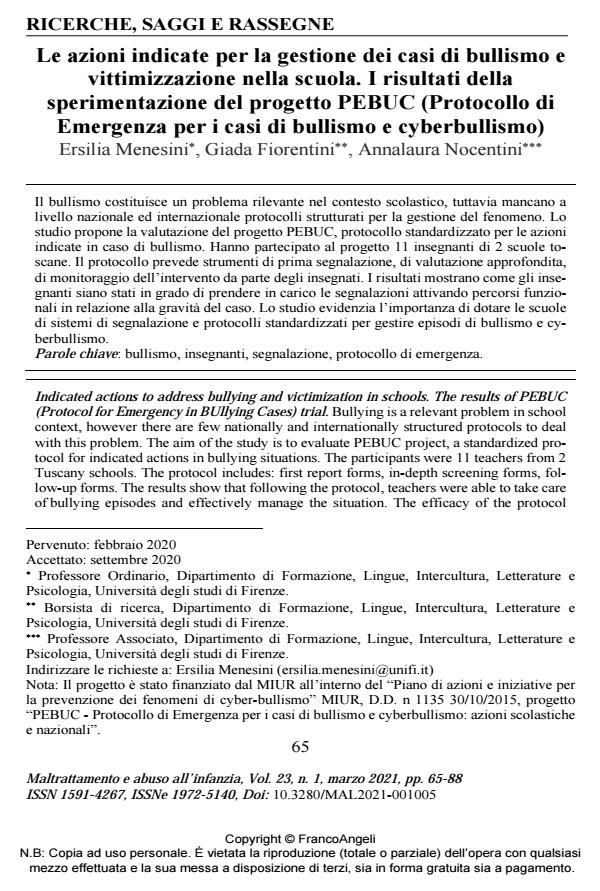Indicated actions to address bullying and victimization in schools. The results of PEBUC (Protocol for Emergency in BUllying Cases)
Journal title MALTRATTAMENTO E ABUSO ALL’INFANZIA
Author/s Ersilia Menesini, Giada Fiorentini, Annalaura Nocentini
Publishing Year 2021 Issue 2021/1
Language Italian Pages 24 P. 65-88 File size 257 KB
DOI 10.3280/MAL2021-001005
DOI is like a bar code for intellectual property: to have more infomation
click here
Below, you can see the article first page
If you want to buy this article in PDF format, you can do it, following the instructions to buy download credits

FrancoAngeli is member of Publishers International Linking Association, Inc (PILA), a not-for-profit association which run the CrossRef service enabling links to and from online scholarly content.
trial. Bullying is a relevant problem in school context, however there are few nationally and internationally structured protocols to deal with this problem. The aim of the study is to evaluate PEBUC project, a standardized pro-tocol for indicated actions in bullying situations. The participants were 11 teachers from 2 Tuscany schools. The protocol includes: first report forms, in-depth screening forms, fol-low-up forms. The results show that following the protocol, teachers were able to take care of bullying episodes and effectively manage the situation. The efficacy of the proto-col underlines how schools need a report system and a structured protocol to tackle bullying and cyberbullying.
Keywords: Bullying, teachers, reporting, emergency protocol.
- Indicated Interventions for Youth Involved in Bullying and Victimization Behaviors: A Systematic Review Nocentini Annalaura, Taddei Benedetta, De Luca Lisa, Menesini Ersilia, in Adolescent Research Review /2025 pp.403
DOI: 10.1007/s40894-024-00255-x - Finché le cose non andranno meglio: discriminazione di genere e slut-shaming nell'esperienza di un gruppo di giovani donne Paola Miano, Chiara Urone, in MALTRATTAMENTO E ABUSO ALL'INFANZIA 1/2025 pp.101
DOI: 10.3280/MAL2025-001006
Ersilia Menesini, Giada Fiorentini, Annalaura Nocentini, Le azioni indicate per la gestione dei casi di bullismo e vittimizzazione nella scuola. I risultati della sperimentazione del progetto PEBUC (Protocollo di Emergenza per i casi di bullismo e cyberbullismo) in "MALTRATTAMENTO E ABUSO ALL’INFANZIA" 1/2021, pp 65-88, DOI: 10.3280/MAL2021-001005